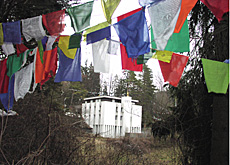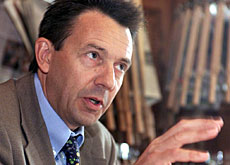East meets West in Swiss Tibet

It is 45 years since an anti-Chinese uprising in Tibet ended with the 14th Dalai Lama fleeing into exile in India.
swissinfo’s Marzio Pescia travelled to Rikon in eastern Switzerland, which is home to a sizeable Tibetan community.
Since March 10, 1959, many other Tibetans have followed their spiritual leader by fleeing to India, the United States, or Switzerland.
My first contact with the Tibetan exile community in Switzerland came about quite by chance. I was in the town centre of Winterthur, about 30 kilometres east of Zurich.
At midday, I went to a restaurant whose name and appearance were very traditional, or so it seemed. I sat down, looking forward to a Zurich-style veal stew, or sausage with onion sauce.
But then came the surprise: as well as the classic dishes of German-speaking Switzerland, the menu offered Tibetan specialities.
To get into the spirit of the place, I ordered “momos”- steamed pasta pouches stuffed with meat or vegetables – and chatted with the owner’s wife. She was middle-aged, and from Tibet.
“I’ve been in Switzerland since I was five,” she told me. “If you’re looking for Tibetans, you should go to Rikon.” Since 1968, Rikon has housed the only genuine Tibetan monastery on Swiss soil.
Refugees
Today, the 3,000 members of the Tibetan community in Switzerland make it the largest in Europe, and the third largest in the world, after those in India and the US.
“Most of us came here more than 40 years ago,” said Jampa Tsering, who chairs the Swiss Tibetan community. “In the early 1960s, the Red Cross helped many displaced Tibetans to get out of the reception camps in India, and obtain refugee status in Switzerland.”
“I arrived in 1998, also from India, where my parents had fled during the disturbances in 1959,” Jampa continued. “I got married in Switzerland and now I work in a factory.”
Jampa is one of about 300 Tibetans who have peacefully “invaded” the small Zurich district of Rikon (1,500 residents).
“Of course, there are a lot of them. But there haven’t been any particular problems with integration,” noted local official Andreas Meyer. “They’re courteous and keep themselves to themselves.”
Nevertheless, the village bears the marks of their presence. Tibetan flags flutter in the gardens of many homes, not to mention the playground of the local school.
“Many [Tibetans] have acquired Swiss citizenship,” said Jampa. But links with Tibetan culture and traditions are still strong, especially among the elderly.
“Our community sponsors seven Tibetan schools around Switzerland, publishes a magazine and organises traditional celebrations,” he added.
The aim is to preserve a language and culture that in Tibet, according to Jampa, are being watered down or disappearing owing to the stifling embrace of the Chinese.
Eight monks of Rikon
Next, I headed for the monastery. It is only a short distance away, on the hill overlooking the village. “It’s a very important place for us. I often go there to pray,” Jampa told me.
The monastery was founded almost 40 years ago, with support from the Dalai Lama himself, to provide support for the growing Tibetan community in Switzerland.
At first glance, the building has little of the East about it. It is a white concrete block standing on a steep slope graced by a multitude of prayer flags. A stupa, or Buddhist temple, nestles in the woods.
Inside the block live eight Buddhist monks who teach meditation and Tibetan language, in addition to carrying out their religious duties.
“I’ve lived here since 1969,” Tokhang Khedup told me, showing me the altar where he prays each morning.
“We have anything from ten to 30 visitors a week. Most are Tibetans, but there are also Swiss who are interested in our history, religion or culture,” added the elderly monk, now a Swiss citizen himself.
Proudly, Jampa told me about the ten visits to the temple made by the Dalai Lama. “The last time was in 1998,” he said. “But we monks, and the entire Tibetan community in Switzerland, hope that he will come back soon.”
swissinfo, Marzio Pescia in Rikon
It is estimated that more than 150,000 Tibetans have fled abroad since 1959.
Switzerland hosts the third-largest Tibetan community in the world, after India and the US.
Tibet is on a plateau 4,000 to 6,000 metres above sea level, bordered by India, Myanmar and China.
Tibet has a surface area of 1,200,000 square kilometres(Switzerland: 41,000 square kilometres) and about 2.5 million inhabitants.
In 1903, Tibet was occupied by British troops. In 1950, the country was invaded (or liberated, according to the Chinese) by the troops of Mao Tse-tung, who had just re-unified China.
In 1959, the first major popular rebellion against the Chinese took place. It ended with the exile of the 14th Dalai Lama.
The spiritual leader set up a Tibetan government in exile in India and has demanded Tibet’s independence from China.
The Swiss government view is that there is only one China – the People’s Republic of China – and that Tibet is part of China.

In compliance with the JTI standards
More: SWI swissinfo.ch certified by the Journalism Trust Initiative

You can find an overview of ongoing debates with our journalists here. Please join us!
If you want to start a conversation about a topic raised in this article or want to report factual errors, email us at english@swissinfo.ch.